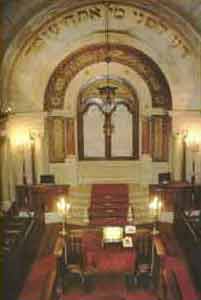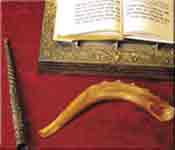Virtual Jewish World: Lisbon, Portugal
Situated on the northern bank of the Tagus estuary, Lisbon, the capital of Portugal, has always been a meeting place for different peoples. Important Jewish communities settled in this region and contributed to the flourishing of Its trade and culture.
Lisbon - Conquered from the Moors in 1147 by Dom Afonso Henriques, the first king of Portugal, the Castle of Sao Jorge stands proudly atop one of the city's seven hills. With a magnificent view over the city, it was the site chosen as the home of the Portuguese court during the first two centuries of the kingdom's existence.
Baixa
Alfama
Belem
Other Places of Interest
Baixa
 Lisbon Synagogue |
A short distance away is the Baixa, traditionally the financial and commercial center of the city, whose parallel streets run into the vast Praca do Comericio, the former Terreiro do Pap, where Dom Manuel I (who reigned from 1495 to 1521) built the royal palace. In this square, flanked by the river on one of its sides, is a beautiful statue of Dom Jose I on horseback. This part of the city was partially destroyed by a violent earthquake on 1 November 1755. From its ruins was to rise up the area known as the Baixa Pombalina, so called because its reconstruction was carried out under the auspices of the Prime Minister of Dom Jose I Marques de Pombal. By ordering these new streets of sober monumentality to be laid out at right angles to one another in the form of a grid, he was to change the face of. Lisbon. At the time when the Jews were expelled from Portugal in 1496, there were two important Jewish quarters in this area: the Judiaria Grande, close to the present-day church of Sao Nicolau, in the street of the same name, and the Judiaria Pequena, created during the reign of Dom Dinis (1279-1325), in the place where the Bank of Portugal stands today, in a street parallel to the Praca do Comercio.
To the east, in Rua da Alfandega, is the Igreja da Conceicao Velha, a church that some authors consider to have been built on an old synagogue and is itself remarkable for its richly carved Manueline doorway. A little further ahead is the dos Bicos, one of the most interesting architectural curiosities remaining from the time of the Discoveries, with its original facade of diamond-shaped stones. There are yet other urban and monumental areas in the city that are linked to the history of the Jews in Portugal: the Praca Dom Pedro, better known as Rossio, where the Court of the Inquisition was held in the Palacio dos Estaus, at the site where the Dona Maria national theatre now stands, built in the 19th century.
Alfama
 Shofar, pointer and Siddur from Lisbon Synagogue |
On tie hillside facing Alfama, on the western side of the Baixa, one of Lisbon's several picturesque yellow funiculars takes visitors up to the Chiado quarter, a shopping area. Here it is interesting to visit the Teatro Lirico de Sao Carlos (built at the end of the 18th century), Museu do Chiado (with its collection of 19th and 20th-century art Portuguese art), and the Igreja de Sao Roque, the best place to begin a tour of Baroque Lisbon. Very close to this, in the Museu Arqueologico do Carmo (the Archaeological Museum), is to be found a great collection of tombstones, amongst which is the "Monchique Stone" with inscriptions written in Hebrew. Until the 14th century, there was a small Jewish quarter here, built on land that Dom Dinis had given to their chief rabbi, Judas Navarro. On the same hill is Bairro Alto, a quarter with a particularly lively nightlife, enlivened by the many small restaurants in the area. At the time of the Portuguese Maritime Discoveries (15th and 16th centuries), this land was owned by a number of Jewish families.
Belem
Close to the river, in Belem, the point of departure of the great fleets of ships that made this golden age possible is marked by the Tower of Belem (classified by UNESCO as World Heritage), built to defend the river between 1515 and 1521, and one of the most gracious and elegant examples of the Manueline style of architecture (a unique form of Portuguese Gothic architecture, which took the name of the king of that time, Dom Manuel 1, although it had in fact first begun to appear even before he came to the throne). The Mosteiro dos Jeronimos (also classified as World Heritage) is another masterpiece from the Manueline period of architecture. Amongst the rich collection of statues carved into the southern portal is one depicting Moses. Several museums of great interest also add to the attractions of this area: the Coach Museum (Museu dos Caches) has a unique collection of 16th to 20th-century coaches and horse-drawn carriages, in particular, those from the Baroque period; the Naval Museum (Museu de Mafinha) has a number of exhibits that are connected with the Portuguese Discoveries, some of which owe their existence to the work of Jewish scientists (such as the astrolabes that were perfected at that time); the Archaeological museum (Museu Nacional de Arqueologia); and also the Belem Cultural Center, an example of much more recent architecture, with its remarkable program of exhibitions and concerts.
At the end of the last century, several groups of Jews from Gibraltar formed a community that ordered the building of the Shaare Tikva (Gates of Hope) Synagogue. This building of sober appearance, the work of the Portuguese architect Ventura Terra, is located at No. 59 Rua Alexandre Herculano in the center of the city.
Several of the most important museums in Lisbon bear witness to the Jewish presence in the city. In addition to its interesting collection of exhibits about the history of Lisbon, the City Museum (Museu da Cidade) in the north of the city has a collection of engravings on the theme of the Inquisition and the "autos-da-fe" that continued to be carried out until the 18th century. Amongst some of the finest paintings at the National Museum of Ancient Art (Museu Nacional de Arte Antiga), one of the most important museums in the country, is the portrait of a 16th-century Jew painted by Grao Vasco. The Paineis de Sao Vicente (the polyptych from St. Vincent's altar), attributed to the great 15th-century Portuguese artist Nuno Goncalves, is a masterpiece in its representation of the different figures of the period from all walks of life. There are some authors who maintain that in the first panel on the fight, the figure seen holding a book is Jewish.
In the eastern part of the city, not far from the site of the 1998 World Exhibition, is the Painted Tile Museum (Museu do Azulejo), which is housed inside a former 16th-century convent and contains a unique collection of Portuguese azulejos. Particularly interesting are a panel of azulejos depicting various scenes from the Old Testament (the sacrifice of Abraham and Moses being protected from the waters of the Nile) and another panel which is of great historical importance since it depicts the city of Lisbon before the earthquake of 1755. The museum of the Arpad Szenes-Vieira da Silva Foundation, in the Jardim das Amoreiras, close to the beautiful 18th-century aqueduct (Aqueduto das Aguas Livres) contains a collection of paintings by the famous artist of Jewish origin who was married to the Portuguese artist Maria Helena Vieira da Silva.
Other places of interest
Traveling westwards from Lisbon, along the bank of the river Tagus and toward the Atlantic Ocean, the visitor arrives at Estoril, a cosmopolitan center with its world-famous casino, golf courses, and grand prix car racing circuit. Further on is Cascais, a small seaside town with many lively restaurants and bars and an interesting architectural heritage. The town of Sintra, perfectly integrated into the surrounding landscape in its delightful setting of exuberant green woodland, was recently uniquely classified by UNESCO as a "cultural landscape."
Palacio da Vila, the former Royal Palace, where Dom Joao I (who reigned from 1385-1433) took the decision to send an expedition to Ceuta, thereby initiating the golden age of Portuguese Maritime Expansion. It was during this period that the Jewish quarter in this area grew around the Palace, greatly contributing to the flourishing of economic and literary activity. Later, Dom Manuel I introduced a number of details that were drawn from Moslem decoration, namely panels of Mudejar azulejos in the interior rooms, as well as certain architectural details from the Manueline style. In the reign of Dom Joao 111 (1521-1557), the Palace was frequently visited by men of letters and humanists who spoke Latin, Hebrew, and Greek. High above Sintra, overlooking the surrounding hills and the ruins of the nearby 8th-century Moorish Castle, stands the Palacio da Pena, a fine example of romantic taste in its eclectic blend of styles. Close to Sintra is the most westerly point of continental Europe, Cabo da Roca, a sheer headland that falls dramatically into the sea.
Elsewhere in this area, in the town of Mafra, is an enormous Baroque palace-monastery with a magnificent library decorated in the rocaille style and surrounded by a splendid hunting ground. On the way back to Lisbon, it is well worth paying a visit to the Palacio de Queluz, built in the rococo style and affording a clear expression of the aristocratic society of the second half of the 18th century. Set in the most beautiful gardens, it was previously the summer residence of the kings and queens of Portugal. Today, its room still contain their original period furniture, and the palace and garden are used for cultural activities in the summer months.
Source: Journey to Jewish Portugal courtesy of the Portuguese National Tourist Office.
Photos by Antonio Sachetti.



